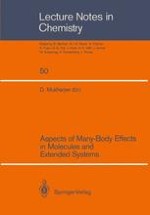1989 | OriginalPaper | Buchkapitel
Spinor Basis in Electron Correlation Studies
verfasst von : C. R. Sarma
Erschienen in: Aspects of Many-Body Effects in Molecules and Extended Systems
Verlag: Springer Berlin Heidelberg
Enthalten in: Professional Book Archive
Aktivieren Sie unsere intelligente Suche, um passende Fachinhalte oder Patente zu finden.
Wählen Sie Textabschnitte aus um mit Künstlicher Intelligenz passenden Patente zu finden. powered by
Markieren Sie Textabschnitte, um KI-gestützt weitere passende Inhalte zu finden. powered by
Spinor representations of generators of the Lie algebra of SO(N)(N=2n, 2n+1; n integer, have played a key role in a number of areas of Physics [1–5]. A general approach to these representations in a form suitable for practical applications has been of recent origin [6–8]. Starting with the unitary algebra of U(2n), the generators of SO(N) and U(n) were realised in the chain U(2n) ⊃ SO(2n+1) ⊃ SO(2n) ⊃ U(n). It was found that the symmetric bispinor basis spanning the representation [2 Ȯ] of U(2n) could be used to subduce the spin-free configurations spanning the representations [2N/2-s, 12s, Ȯ] of U(n). Some preliminary studies of generating the configuration space in this manner have recently been carried out for basis adapted for the chains U(n)⊃...⊃ U(1) [8] and U(n) ⊃ SO(n) ...⊃ SO(2) [9]. From a practical point of view this approach has a basic drawback. This is the fact that the simple one electron orbital description of spin-free configurations is masked in using the spinor basis. In the present study we examine the possibility of inducing a basis spanning the representations of U(2n) and SO(N) starting with the antisymmetric representations, [1N, Ȯ] (0≤N≤n; N integer) of U(n). The aim is to provide a simple interpretation of the spinor basis in terms of the tensor (integer) representations of U(n).
